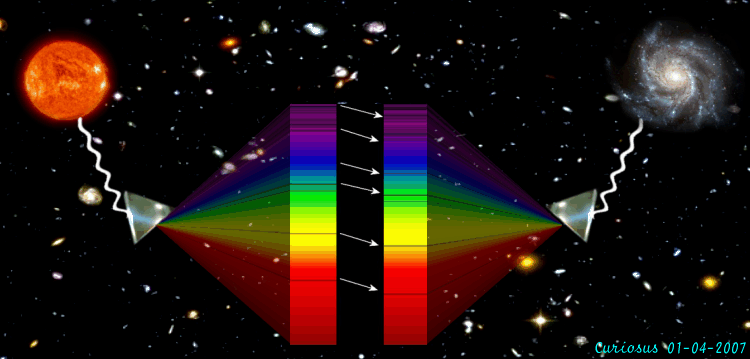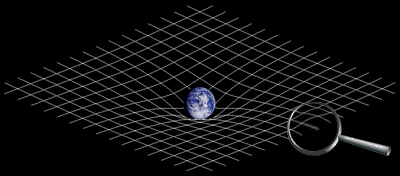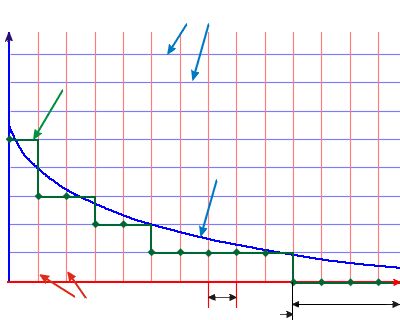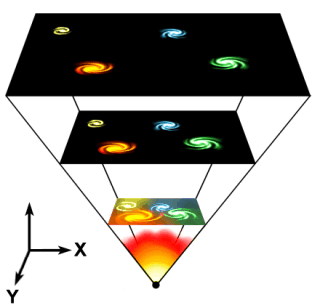Expansion of the Universe
and its acceleration
The Sampling Universe Theory provides a natural and simple explanation for
the expansion of the universe and its acceleration. In a sampled universe, the
forces of gravitation are cancelled past a critical distance. But particles can
travel in empty space without limit, so that over long distances the radiation
pressure from the stars prevails and is causing the expansion of the
sampled universe.
3. Current facts: the red shift, the expansion of the universe
and its acceleration
By using spectrometers, astronomers can observe the individually colored
components of the light we receive from stars and galaxies. The spectrometer is
producing some kind of a rainbow which is called a spectrum.
When looking at the spectrum of the Sun, we see a pattern of dark bands
which are the signature of its chemical composition. When looking at the
spectrum of a distant galaxy, wee see the same pattern of dark bands, but
shifted towards the red part of the spectrum. This means that:
1. Distant galaxies are made of the same matter as our
Sun
2. The frequency of the light from distant galaxies is
lowered
Consequence : homogeneous universe and isotropic
expansion
The only way to explain these lower frequencies is to consider that
the galaxy is receding. The frequency of the light is lowered, like the
sound of a car moving away from us. As the red shift is increasing with
distance, this means that our universe is expanding.
After measuring thousands of galaxies, it has been discovered
that this expansion is isotropic (the universe looks the same way in
all directions) and that the universe is homogeneous (the universe has
roughly the same smooth mixture of material at every location.) That is
important to consider these two facts when trying to build a theory.
Acceleration of the expansion
1998 was a year of great surprises for cosmologists. According to theories
of the times, the universe should eventually collapse under the effect of the
forces of gravitation. But it was discovered by an international team of
astronomers that the expansion of the universe was in fact accelerating.
Cosmologists had to invent a new kind of energy, the dark energy, in order to
explain that acceleration.
So, in brief, the observed facts are:
- The spectrum from distant galaxies is red shifted
- The universe is expanding
- The expansion is isotropic
- The expansion is accelerating
These facts are simple enough, but that is more difficult to build a
satisfying theory.
1. The forces of gravitation become null over long distances
The statement that the forces of gravitation become null over
long distances is not part of classical gravitational theories. But that would
be a natural consequence of the sampling hypothesis, which is itself a logical
consequence of quantum mechanics.
General relativity is currently the most successful gravitational theory,
being almost universally accepted and well confirmed by observations. Hence we
are using it as our start point.
Space-time bending
According to General Relativity, the presence of matter changes the
geometry of spacetime, and this curved geometry is causing gravity.
The picture to the left represents a two-dimensional analogy of
the space-time distortion caused by a massive body. The presence of matter
changes the geometry of spacetime, this (curved) geometry being interpreted as
gravity.
The light follows the curvature of space and is
bent
by the gravitational field.
Sampled curvature
According to the sampling universe theory, space is sampled (the length of
Planck being the sampling resolution), so that the curvature of space is sampled
too.
This means that when we are far enough from the mass causing the curvature,
the curvature of space becomes smaller than the length of Planck, hence it
becomes in fact null and gravity is cancelled.
4. Current theories: Big Bang, Cosmic Inflation and Dark Energy
Appendix:
Evaluating the radiation pressure from our local group of
galaxies on another galaxy
2. Radiation pressure is strong enough to cause the expansion
The example of comets
Radiations from the stars exert a pressure when they encounter a
body.
For example radiation pressure from the sun is creating the tail of comets.
The picture to the left shows the Hale-Bopp comet in March 1997:
Classical
continuous curvature
The figure above is comparing the classical curvature with the sampled
curvature.
With the formulas of classical general relativity, the
curvature (blue curve) is a continuous function of space, time and mass and is
allowed to become infinitely small.
With the sampling hypothesis, space is discrete, so that
the curvature of space (in green) cannot become infinitely small: when
it becomes smaller than the length of Planck, it is cancelled, hence gravity is
cancelled.


Why is the body of a comet not repelled by radiations, but its tail
is?
The answer is very simple: the acceleration from radiation pressure
increases as the size of the body decreases. When applied to dust and gas,
radiation pressure becomes quite noticeable.
Basic formula
When radiations encounter a body, they exert a pressure which is
communicating an acceleration to that body, according to the formula:
Acceleration = (Pressure x Surface) / Mass
When the
diameter of the body is divided by 2, its surface is divided by 4 but its
mass is divided by 8, hence the acceleration is multiplied by 2.
Dust and gas repelled by radiation pressure are forming the tail
The
main body of the comet is not affected by radiation pressure
Now we have to consider a very
important feature of the universe:
98% of the mass of galaxies is made of hydrogen and
helium, in molecular and dust form.
So galaxies are very sensitive to radiation pressure, even over
intergalactic distances. As gas and dust form 98% of the total mass of galaxies,
they attract the remaining 2% which are stars and planets. Eventually the whole
galaxy is propelled by radiation pressure.
In brief, over intergalactic distances, past a critical distance,
the forces of gravitation are cancelled when the acceleration from radiation
pressure is strong enough to propell galaxies. Hence the universe is
expanding.
Now we can compare this result with current facts and theories.
The following section is providing an estimation of the
acceleration exerted by our local group of galaxies on another galaxy
placed at the level of the critical distance between attraction and
repulsion.
That is a rough estimation only, as we are interested only in order of
magnitudes, in order to check whether actual accelerations from radiation
pressure are strong enough to propel galaxies.
Principle of a quantitative evaluation
The assumptions made are in agreement with the generally accepted data
from current cosmology.
1. We consider the example of our local group of
galaxies
2. The local group is the "source", the radiation emitter
3. We
assume that the local group includes 700 billion stars
4. We consider that
the main mass of each galaxy is made of dark matter
5. We consider that dark
matter is made for the main part of gas
6. Hydrogen is the dominant gas in
the universe
7. So we place atoms of hydrogen at the zero acceleration
limit
8. We calculate the acceleration of gas caused by radiation
pressure
9. We compare it with the acceleration of the expansion of the
universe
Eventually we find that the acceleration from
radiation pressure is similar to the acceleration of the expansion of the
universe.
We are using the example of our local group of galaxies, as the zero
acceleration limit has been accurately measured. This limit separates the inner
region, in which the gravitation of the galaxies dominates, from the outer
region, in which the expansion of the universe dominates.
If now we assume that at the zero acceleration limit, in the frame of the
theory of the sampled universe, the forces of gravitation are too weak to exist,
the pressure of radiation is sufficient to explain the expansion of the
universe.
Basic units and symbols
- * Is the symbol of multiplication (from C language)
- Pa = Pascal = unit of pressure
- Distance from Sun to Earth = Astronomical Unit (Symbol AU)
- 1 Megaparsec (symbol Mpc) ~ 2.0 * 1011 AU
- Basic data from current observations of the universe
(1) Radiation
pressure from Sun to particles ~ 2.2 * 10-5 Pa
(2) Zero
acceleration limit for our local group of galaxies ~ 2 Mpc
(3) Number of
stars in our local group ~ 700 billion
(4) Size of an atom of hydrogen ~
10-10 m
(5) Mass of an atom of hydrogen = 1.7 *
10-27 kg
(6) Hubble acceleration (expansion rate) ~
6.9 * 10-10 ms-2
Formulas
1) Radiation pressure at a 2 Mpc distance
1a) Radiation Pressure from the Sun at a 2 Mpc distance (RPS):
Radiation
Pressure obeys the inverse distance square law, hence
RPS = (2.2 *
10-5) / (4 * 1011)2 = 1.4 *
10-28
1b) Radiation Pressure from the local group of galaxies at a 2 Mpc distance
(RPG):
The local group of galaxies includes 700 billion stars, and we assume
that the mean value of the radiation pressure from the stars is similar to the
radiation pressure from the Sun. Hence:
RPG = (1.4 * 10-28) * (7 *
1011) = 9.8 * 10-17
2) Acceleration of gas at 2 Mpc distance (AG)
We consider a gas made of atoms. We take as an example hydrogen, the dominant
interstellar gas
By using the formula : Acceleration = (Pressure * Surface) /
Mass
Surface of an atom of hydrogen = 7.9 * 10-21
AG = (9.8 *
10-17) * (7.9 * 10-21) / (1.7 *
10-27) ~ 4.5 * 10-10
3) Comparing the results
Hubble acceleration:
6.9 * 10-10 m / s2
Acceleration of hydrogen at a 2 Mpc distance caused by radiation
pressure:
4.5 * 10-10 m / s2
The two numbers are similar, of the same order of magnitude.
If gravity forces are cancelled at a 2 Mpc distance, as they are below the
sampling resolution limits, this means that the acceleration from radiation
pressure is strong enough to cause the acceleration of gas and dust.
As 98% of the distant galaxy is made of hydrogen and helium, in molecular and
dust form, 98% of the galaxy is accelerated, then stars and planets follow as
they are bound to gas and dust by gravity.

Currents theories are:
Big Bang theory, to explain the expansion
According to the Big Bang theory, there was an original explosion which
propelled all matter from a very small point. The expansion comes from the
original impulse of the explosion.
Cosmic Inflation, to explain the isotropy
With the theory of the explosion, the universe would not be homogeneous. So
cosmologists added a new theory: the cosmic inflation. Cosmic inflation is the
idea that the nascent universe passed through a phase of exponential expansion
that was driven by a negative-pressure vacuum energy density, caused by a new
particle, the Inflaton.
Dark Energy, to explain the acceleration of the
expansion
The acceleration of the expansion is explained by the existence of a new kind
of energy, the dark energy.
These theories create several problems
Problems with the Big bang theory
When claiming that the universe was born in an explosion, the Big Bang theory
does not explain from where this huge energy and impulse are coming. That
sounds like magic: something appears suddenly from nowhere without any rational
explanation.
Moreover with a single original explosion, the universe would not be
isotropic: it was necessary to add the theory of cosmic inflation.
Then, as the expansion apparently is going to continue forever, this means
the production of a continuous energy, as in order to move away a galaxy
forever, you need to apply a never ending force on that galaxy. That is
difficult to explain how the production of an infinite energy can be embedded in
a single original explosion.
Problem with cosmic inflation
The theory of cosmic inflation is supposing the existence of a new particle,
the inflaton, which has never been observed.
Problem with dark energy
Dark energy has never been directly observed, and currently it cannot be
explained by current theories of matter and energy.
5. Problems with current theories
7. Comparing current theories with the Sampling Universe Theory
Current theories are based on arbitraries assumptions: the Big
Bang, the Inflaton, dark energy. These assumptions allow explaining the
observed facts, but any other hypothesis explaining the same facts is acceptable
as well.
The Sampling Universe Theory is explaining the same facts by using the basic
assumption that space and time are discrete. This assumption makes sense when
considering that Quantum mechanics demonstrated that matter and energy are
discrete, and that time cannot be smaller than the time of Planck and that space
cannot be smaller than the length of Planck.
So the Sampling Universe Theory does not
introduce any new component really, it is just considering the natural
consequences of an application of both Quantum Mechanics and General
Relativity.
Hence the Sampling Universe Theory is less
arbitrary than current theories.
6. An explanation for the expansion of the acceleration
We have seen at the beginning of this article that the universe is evolving
under the influence of two main forces: the forces of gravitation, and the
forces exerted by radiation pressure.
But how to explain that the expansion is accelerating?
By rewinding the film of the expansion, we have apparently a point, 14
billion years ago, where all matter was concentrated in a single point, hence
the theory of the Big Bang.
But with the sampling hypothesis, there is a difference: as expansion comes
from the light and radiations emitted by stars and galaxies, eventually we come
back to a point where there are no galaxies, hence there is no expansion.
When rewinding the film, there are less and less galaxies, thus the expansion
is slower and the universe could be much older than 14 billion years.
This scenario explains why the expansion of the universe is
accelerating: as more and more stars are formed from hydrogen and dust, the
amount of radiation in the universe is increasing, so the expansion is
accelerating.
Currently there are several theories proposed to explain the acceleration of
the expansion: dark energy, vacuum energy, etc. There is not yet a general
agreement amongst cosmologists about the cause of that acceleration.
The sampling hypothesis is explaining that acceleration quite well.
The figure above illustrates spectrum analysis, one of our main tools to
observe the universe. This technology is so simple and accurate
that the expansion of the universe is almost a certainty, when current
theories are not so certain.
Spectrum analysis of the light from distant galaxies
The picture above (from Wikipedia) represents the Big Bang and the
expansion







